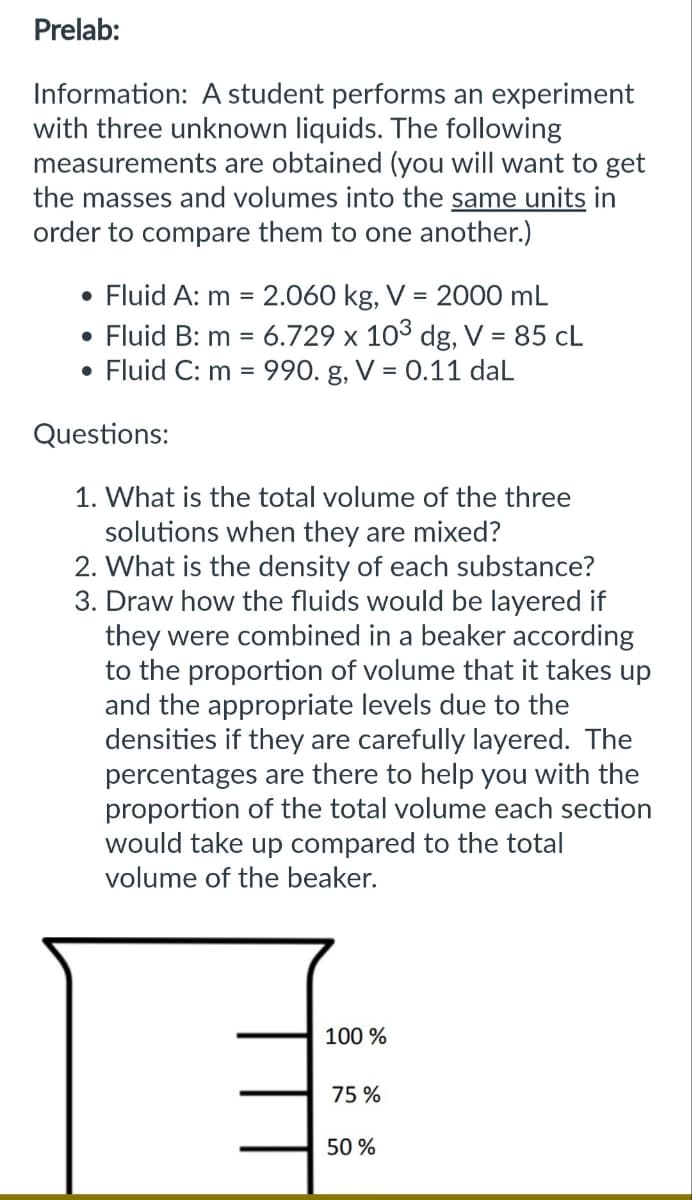Information: A student performs an experiment with three unknown liquids. The following measurements are obtained (you will want to get the masses and volumes into the same units in order to compare them to one another.) • Fluid A: m = 2.060 kg, V = 2000 mL • Fluid B: m = 6.729 x 103 dg, V = 85 CL • Fluid C: m = 990. g, V = 0.11 daL Questions: 1. What is the total volume of the three solutions when they are mixed? 2. What is the density of each substance?
Information: A student performs an experiment with three unknown liquids. The following measurements are obtained (you will want to get the masses and volumes into the same units in order to compare them to one another.) • Fluid A: m = 2.060 kg, V = 2000 mL • Fluid B: m = 6.729 x 103 dg, V = 85 CL • Fluid C: m = 990. g, V = 0.11 daL Questions: 1. What is the total volume of the three solutions when they are mixed? 2. What is the density of each substance?
Principles of Instrumental Analysis
7th Edition
ISBN:9781305577213
Author:Douglas A. Skoog, F. James Holler, Stanley R. Crouch
Publisher:Douglas A. Skoog, F. James Holler, Stanley R. Crouch
ChapterA1: Evaluation Of Analytical Data
Section: Chapter Questions
Problem A1.3QAP
Related questions
Question
Please help with question 2

Transcribed Image Text:Prelab:
Information: A student performs an experiment
with three unknown liquids. The following
measurements are obtained (you will want to get
the masses and volumes into the same units in
order to compare them to one another.)
• Fluid A: m = 2.060 kg, V = 2000 mL
• Fluid B: m = 6.729 x 103 dg, V = 85 CL
Fluid C: m = 990. g, V = 0.11 daL
Questions:
1. What is the total volume of the three
solutions when they are mixed?
2. What is the density of each substance?
3. Draw how the fluids would be layered if
they were combined in a beaker according
to the proportion of volume that it takes up
and the appropriate levels due to the
densities if they are carefully layered. The
percentages are there to help you with the
proportion of the total volume each section
would take up compared to the total
volume of the beaker.
100%
75%
50%
Expert Solution
This question has been solved!
Explore an expertly crafted, step-by-step solution for a thorough understanding of key concepts.
Step by step
Solved in 4 steps

Knowledge Booster
Learn more about
Need a deep-dive on the concept behind this application? Look no further. Learn more about this topic, chemistry and related others by exploring similar questions and additional content below.Recommended textbooks for you

Principles of Instrumental Analysis
Chemistry
ISBN:
9781305577213
Author:
Douglas A. Skoog, F. James Holler, Stanley R. Crouch
Publisher:
Cengage Learning

EBK A SMALL SCALE APPROACH TO ORGANIC L
Chemistry
ISBN:
9781305446021
Author:
Lampman
Publisher:
CENGAGE LEARNING - CONSIGNMENT

Principles of Instrumental Analysis
Chemistry
ISBN:
9781305577213
Author:
Douglas A. Skoog, F. James Holler, Stanley R. Crouch
Publisher:
Cengage Learning

EBK A SMALL SCALE APPROACH TO ORGANIC L
Chemistry
ISBN:
9781305446021
Author:
Lampman
Publisher:
CENGAGE LEARNING - CONSIGNMENT